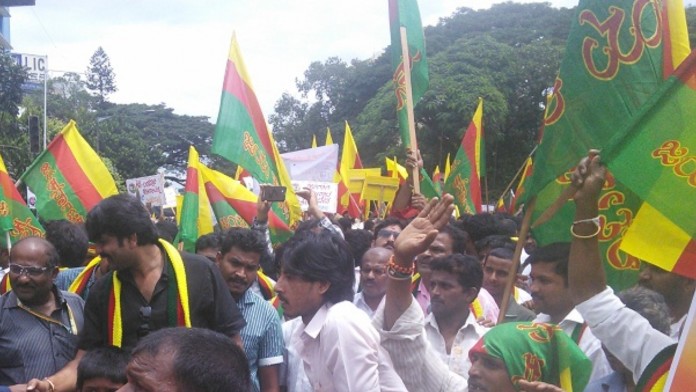The new Bill and the 2020 BBMP elections promise some action and hope
Bengaluru has been envied for its civic activism, yet the city continues to be in a big mess with slowest-moving traffic in the world. The politician-bureaucrat-real estate stranglehold on the city is proving to be impenetrable leaving citizens and citizen activists gasping. “Citizen activism fatigue has set in,” says Meera K, founder of Citizen Matters, an online magazine meant to engage citizen’s in their city’s development. Citizen Matters is now active in most Indian cities.
This is good news for the corporators, MLAs and MPs, for whom Bengaluru has been a milch cow to get obscenely rich in quick time. This is done so brazenly that it’s no longer a joke. For example, a party that criticized a mega project tooth and nail when in opposition, takes up the same project when it comes to power. The latest example is the mouth-watering Rs. 25,000 crore elevated corridor project which the citizens have been opposing vehemently. This at the cost of a decade-old demand for a circular railway project that could decongest the city significantly. Its current cost is estimated at Rs. 18,000 crore.
V Ravichandar, mentor to city activists, an active member is many committees and chairman of Feedback Consulting, relates Bengaluru’s condition to the Greek mythical story – the Curse of Sisyphus. The story is essentially about the futility of effort. Sisyphus had brought upon himself the wrath of the gods for which he was cursed to push a boulder up a hill but before it reached it rolled back to the bottom. This ordeal is supposed to go on uninterrupted. “We have an invisible reverse Sisyphus Curse here. One mysterious person on top of the hill keeps pushing the boulder down with the flick of a finger. This is the heart of the problem of the city,” he said while speaking at a panel discussion of the Bengaluru Habba in February 2020.
City activism in Bengaluru made a promising start during the tenure of S M Krishna, chief minister of Karnataka between 1999 and 2004, largely because, it turns out, he’s the only head of the state government who represented the city since its formation in 1956.
Janaagraha, founded by Swati Ramanathan and Ramesh Ramanathan in December 2001 “to catalyze active citizenship in city neighborhoods and with governments to institute reforms to city governance,” believed in a bottom-up approach. While it continues its mission, it has had a limited success in getting citizens to be part of the decision-making process at the ward level in greater numbers.

Despite tepid success of two major initiatives involving prominent business leaders and citizens during the decade of 2000, citizen activists have been persevering to have cleaner governance and a say in the city’s policy making. Having learnt from its predecessors’ mistakes, prominent citizens Kiran Mazumdar Shah, Mohandas Pai, K Jairaj, Harish Bijoor and a few others started the Bangalore Political Action Committee (BPAC) just before the 2015 BBMP elections. BPAC believes that external pressures were not working and change was possible by having a toehold inside the system.
It started with financially supporting ‘clean’ candidates among the prominent political parties with the slogan ‘Na Khaoonga, Na Khane Dunga’ (won’t take nor will let others take bribe). When 23 candidates it supported won the BBMP polls in 2015, it seemed citizen activism had made a breakthrough.
Yet, the city seems to have got only cosmetic progress in the form of a few better-maintained lakes and a few well laid-out roads in popular commercial areas. It’s basic problems of waste management, pothole-free roads, better connectivity, citizens’ safety, are still in the grips of mafias connected with all the prominent political parties. Even the government-appointed committees for better governance like the Kasturirangan Committee, ABIDE and the BBMP Restructuring Committee are gathering dust.

“Can Bengaluru flourish sans a structural reform of governance and administration? How long can we continue with business as usual or band aid fixes?” was the brief for the panel that discussed the city’s future at the Bengaluru Habba. That ‘Is Urban Governance: An oxymoron?’ was the title of the panel session, goes to show how helpless and hopeless citizens are beginning to feel in a city that is ranked as not only India’s but Asia’s top start-up capital and has the largest R&D facilities of MNCs outside the US. The panelists were Tara Krishnaswamy (Left), Meera K (Middle) and V Ravichandar.
New Act for Bengaluru
Two decades of activism involving several prominent citizens have had little success in improving the city’s governance structure and quality. The BJP, the current ruling party, had stated in its 2019 election manifesto that it would introduce a separate Act for Bengaluru if voted of power. The way the party has gone about introducing the Bill in the state assembly recently without any public consultation has raised many questions about its real intentions.
In a recent opinion piece in the Times of India Bangalore edition, V Ravichandar wrote “It’s a new legislation for BBMP (not for the city). It does not address the unique problems of Bengaluru with its multiplicity of authorities and civic agencies working at cross purposes.”
The Bill does have a few seemingly progressive features like a directly-elected mayor with a fixed five-year tenure. But it does not say whether the Mayor will have real executive powers. It’s also silent about whether the MPs, MLAs, MLCs representing the city will be honorary members in the BBMP Council or will they be allowed to arm twist the Mayor.
Once normalcy returns after the current pandemic it would be interesting to see how the discussions about the Bill in the State Assembly plays out. It has indeed raised hopes of civic activists who may have to regroup and make the best out of this opportunity.
2020 BBMP Elections
Activists also believe a few more structural changes are needed. Despite Bengaluru contributing to 50% of the GDP of the state, it is represented by only 26 MLAs in the 224-member state assembly. Ravichandar suggests a significant increase in the city’s representation so that they could have a greater say in the city matters. The way to achieve this appears complicated since constituencies are demarcated by population size rather than their economic contribution.
Political activist Tara Krishnaswamy suggests the Chennai model to decongest Bengaluru by breaking up the city where its satellite areas are made part of the adjoining districts. Not sure how this could benefit considering that governance at the district level is even worse.
One of the key reasons for Bengaluru’s poor governance is that it’s run by multiple agencies. Bringing all these agencies under BBMP is feared to create more problems because of the abysmal credibility corporators enjoy. It’s like inviting wolves to sort out a brawl in a doghouse.
Democracies, despite their faults, are the best citizens have. Activists have an opportunity to think different and strategise smartly in the 2020 BBMP elections expected later this year. There could be a room for an outside player to shake things up a little because when it comes to sharing the spoils of the city, all the parties here take turns and even work together.
The Aam Aadmi Party is trying to make an entry into the city after its tremendous success in Delhi earlier this year. If it can pick a few clean and vocal local leaders, if BPAC can support clean candidates like it did in 2015, and if Arvind Kejriwal is able to campaign aggressively, the stranglehold on the city by the mafias supported by political parties could be loosened.









